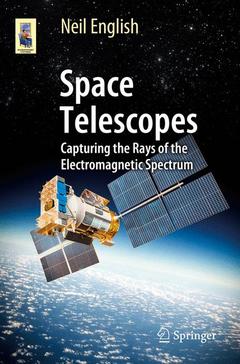Description
Space Telescopes, 1st ed. 2017
Capturing the Rays of the Electromagnetic Spectrum
Astronomers' Universe Series
Author: English Neil
Language: English
Subjects for Space Telescopes:
Publication date: 11-2016
Support: Print on demand
Support: Print on demand
Description
/li>Contents
/li>Biography
/li>Comment
/li>
Space telescopes are among humankind?s greatest scientific achievements of the last fifty years. This book describes the instruments themselves and what they were designed to discover about the Solar System and distant stars. Exactly how these telescopes were built and launched and the data they provided is explored.
Only certain kinds of radiation can penetrate our planet's atmosphere, which limits what we can observe. But with space telescopes all this changed. We now have the means to "see" beyond Earth using ultraviolet, microwave, and infrared rays, X-rays and gamma rays.
In this book we meet the pioneers and the telescopes that were built around their ideas. This book looks at space telescopes not simply chronologically but also in order of the electromagnetic spectrum, making it possible to understand better why they were made.
Acknowledgements.- Preface.- Chapter 1: Light: Nature's Great Information Superhighway.- Chapter 2: The Hubble Space Telescope - Tragedy and Triumph.- Chapter 3: Hubble - The People's Telescope.- Chapter 4: The Infrared Universe.- Chapter 5: The Gamma Ray Universe.- Chapter 6: The Universe Through Ultraviolet Eyes.- Chapter 7: The X-Ray Universe.- Chapter 8: Probing the Microwave Sky.- Chapter 9: Empire of the Sun.- Chapter 10: Measuring the Heavens.- Chapter 11: Looking to the Future: The James Webb Space Telescope.- Useful Websites on Space Telescopes.- Glossary.- Bibliography.- Index.
Dr. Neil English is an Irish citizen with a BSc in Physics & Astronomy, and also a PhD in Biochemistry. He is a Fellow of the Royal Astronomical Society, and a regular contributor to Astronomy Now (the UK’s major astronomy magazine), as well as to Ireland's Astronomy & Space. Dr. English’s astronomical images have been published in various magazines and journals, including a full page in the June 2006 issue of Astronomy. Dr. English has, and continues to, make contributions to Cloudy Nights in the form of several detailed telescope reviews. He is the author of Guide to Mars (Pole Star Publications, 2003) and he has three books published by Springer: Choosing and Using a Refracting Telescope (2010), Choosing and Using a Dobsonian Telescope (2011), Classic Telescopes (2012). His fourth book with Springer is Grab ‘n’ Go Astronomy (2014). Dr. English currently has (among other instruments) a large 12-inch Dobsonian which he uses on the darkest, steadiest nights at his home in ruralScotland.
Explores the fascinating story of how we have deployed space-based observatories to greatly extend our knowledge of the Sun, the family of planets in the solar system, and the cosmos far beyond Shows how different parts of the electromagnetic spectrum provide different information about the universe – and why specialized space observatories are needed Discusses the future of space telescope technologies and the status of space telescopes that are now being built or on the drawing board Includes supplementary material: sn.pub/extras
© 2024 LAVOISIER S.A.S.
These books may interest you

Physics of the Plasma Universe 189.89 €



